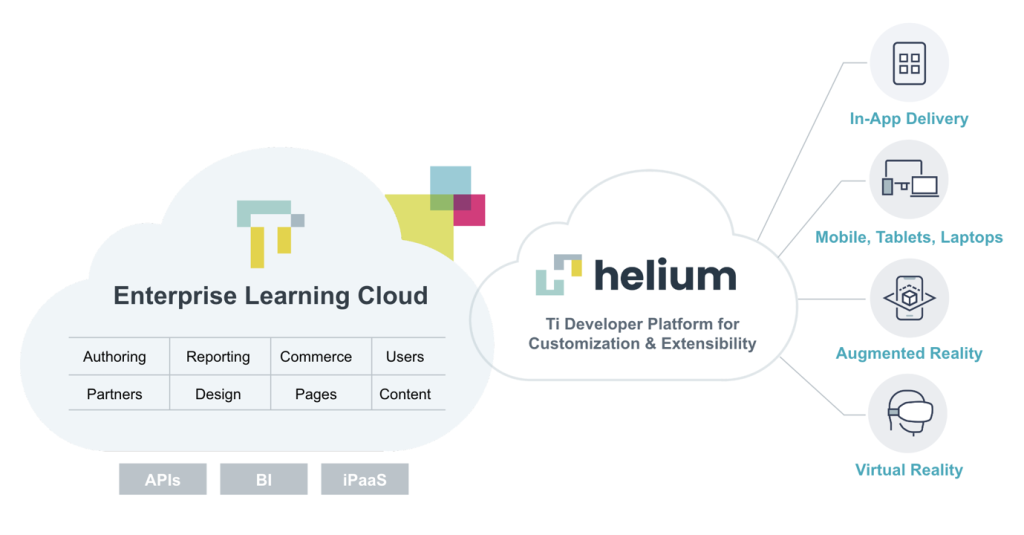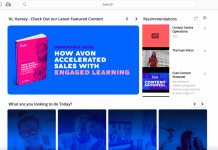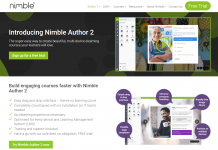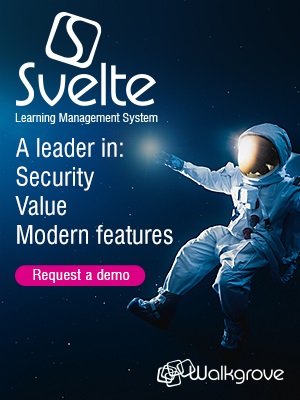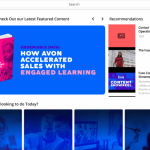What is a headless LMS? Well, this concept in the world of learning management systems is following the trend towards headless CMS (Content Management Systems).
The LMS and CMS have both been around for some time and share similarities in what they do. They both manage and publish content, the CMS to a website and the LMS to web pages or an internal platform tailored to learning.
Both the headless LMS and CMS allow for content to not only to be published to a website or primary platform, but also across a range of channels. The system does not have a single presentation layer – as it is ‘headless’, it is a content repository with a powerful administration interface to support content management and creation.
The publication of the content relies on using APIs (RESTful API) to publish content to multiple display types each with their own presentation layer.
Content can be published to a website, to mobile Apps, to e-commerce sites, through a VR headsets and AR, smart watches and other IOT devices, chatbots, Knowledge hubs, other SaaS applications (and whisper it – even for print), now referred to as omni-channel content management.
Headless CMS are becoming very popular and there is a lot more to this than just plain publishing. There are subsets and variants including decoupled CMS which act in very similar ways and solutions are offered to convert legacy CMS to Headless.
Nonetheless, it would be very cool if LMS were capable of publishing learning in such a way. Well, the good news is that many LMS vendors are on this journey, and with RESTful APIs and some innovative thinking, the Headless LMS is arriving.
So, what can the headless LMS do?
Well, we really can look forward to learning in the workflow, the LMS via APIs will be firmly in the tech stack at the point of need, but we are stepping beyond just a link to the LMS and the benefits of Single Sign On (SSO). What is now possible is the content player itself is integrated into the business application itself.
This can range from Microsoft Teams, the Google Suite and Slack through to CRMs such as Salesforce.
This actual integration of the player means content can be streamed directly into a business application, intranet or indeed a website, and through to mobile applications rendering videos, SCORM content or learning resources truly at a moment of need.
So, like the CMS, the LMS is making content available to the learner pretty much where ever they are in whatever system or application they happen to be working in.
The capability of the headless LMS doesn’t end there. APIs, can pull in learning resources that have been curated in the LMS, so those web based resources such as YouTube etc.
A headless LMS will allow for social learning experiences to be mediated outside the constraints of the LMS and take place in the organisation’s applications. This brings great advantages in sharing and collaboration, with organic communities of practice now much more likely to emerge rather than the more prescriptive attempts to create communities of practise.
The reporting and analytics capabilities of the Headless LMS are also very noteworthy. Data can be exported from the Headless LMS directly into powerful data visualisation suites, bringing learning records and transcripts of learning activities into and alongside the organisation’s other key performance data. the insights that can be achieved from this are considerable.
So while there are parallels between the headless CMS and the headless LMS, the ability of the headless LMS to deliver learning is very considerable.
If we broaden the conversation to understand the headless LMS in the context of Extended Enterprise, the power of the headless LMS to render learning content to customers, distributors, franchisees, along supply chains etc… becomes truly apparent.
The headless LMS means learning content can be made available natively in multiple customer support websites for example.
Top Headless LMS Solutions
While this is not (yet) a widely discussed topic in the world of elearning, there are several learning management systems on the market with the ability to deliver headless LMS benefits.
Adobe Captivate Prime are one of the market leaders in the world of Headless LMS at present, with a lot of dedicated advice published, and a focus on this type of functionality.
However, several others are certainly worth considering as they all come from slightly different angles. Ones to watch in our opinion are:
The Thought Industries Enterprise Learning Cloud allows clients to build their own front-end user experience on top of the foundational LMS solution, and extend it out to different channels and devices.
Their headless LMS software solution delivers powerful back-end functionality while leaving the front-end display layer completely up to the customer. It enables omnichannel learning options for learners, whether or not they’re in front of a computer.
Brightspace from D2L is highly capable and the analytics is hugely impressive, with great integration capabilities.
Valamis, an LXP who leverage the capability of Liferay DXP are well worth considering for their content management and distribution capability.
IMC are a long way down the road of the headless LMS, their Learning Suite product being exceptionally capable.
Looop also have very interesting and evolving capabilities in this space.
Can We Help You?
Interested in discussing how to leverage a headless LMS within your organisation or how to choose the best provider to meet your needs? Contact us here at Learning Light.

David Patterson
Lead eLearning Consultant
About David
Our lead elearning consultant David Patterson is an expert in training technologies such as learning management systems, and in elearning best practices.
He has helped many public and private sector organisations across the UK, Europe and worldwide to create and deliver engaging, effective elearning.
David is joint author of several research papers including the highly acclaimed Learning Light reports on the UK elearning market.




